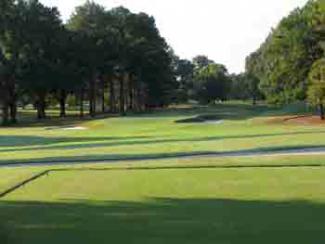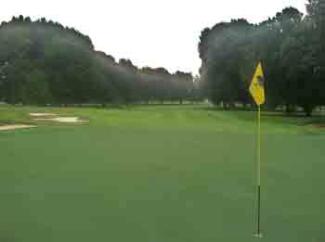Featured Golf News
Ross's Genius Shines at Underrated Memphis Country Club
The Memphis Country Club is not one of those hoity-toity confines where pomp is more important than authenticity or where ceremony is cherished over good quality service to its members, many of whom are the movers and shakers of society in this, one of the most genteel of Southern cities.
The same canons are on display at Memphis CC's wonderful golf course, which was born in 1905 and brought, for the large part, to its current routing in 1910 by the incomparable Donald Ross, one of the great golf architects of the game's Golden Age.
Ross's work on the tiny track of land in the midst of Memphis, in a neighborhood bordered on the north by the posh Central Avenue and on the south by the anything-but-tony rail lines along Southern Avenue, is understated and almost perfect. In the past few years, work by Greensboro, N.C.-based architect Kris Spence has restored tee boxes and green complexes at the course to as near as possible to the track Ross originally designed.
If anything, Memphis CC has become even more demanding during in the past 103 years. It remains the ultimate shot-makers course, cherished by its members and their guests.
Memphis CC is good enough to have hosted the Western Open in 1913, as well as the 1920 and 1933 Western Amateur, the 1948 U.S. Amateur, the 1959 USGA Senior Amateur and the U.S. Women's Amateur in 1937 and 1979.
Everything about the experience at Memphis Country Club exudes class, understatement and tradition. Most of that comes from its members and the club's accommodating staff, where - once through the gate - Southern charm is epitomized to the nth degree.
Aside from a shallow cement drainage ditch, you won't find one water hazard in the 105-acre property that houses Memphis CC. But - thanks to Ross's demanding, often-crowned putting surfaces and the placement and shape of the course's bunkering - the growth of the site's trees through the decades, the 6,709-yard, par-70 course carries a stout 73.6 rating and 142 slope from its back set of four tees.
Employing every inch of the almost-square tract, Ross routed the front nine in a counter-clockwise direction along the property's boundary and then fashioned the majority of the back nine using two interior loops, including a demanding, but inspired triangle of terror, on holes 15-17.
There is a considerable amount of rise and fall in the routing here, a fact that becomes readily apparent on the opening hole, a 408-yard par-4 that plays slightly downhill and to the right and ends on a nearly round green guarded by bunkers on both the left and right.
The real test at Memphis CC takes hold on the 580-yard par-5 third, which is narrow and straight and plays slightly uphill the entire length, even on the approach to a putting surface that is long and segmented.

The Volcano Green of the 4th hole at Memphis CC
Ross's true design genius is on display at the 154-yard par-3 fourth. Here the tee shot is struck from a slightly elevated tee box to one of the architect's famous "volcano" greens, where the putting surface is perched and there is dramatic falloff, and deep bunkering on all sides.

The 7th Hole at Memphis CC
The innocuous-looking 191-yard par-3 seventh is actually one of the toughest holes at Memphis CC, thanks to a slightly raised but sloping green and two penal bunkers that await those shots hit short of the putting surface.

The 15th green at the Memphis CC
The routing at Memphis CC is likewise characterized by its challenging two-shotters, none more so that the short 313-yard ninth, the 415-yard 13th (which has the most severe dogleg on the course - and, likely, the most demanding tee shot because of the overhang of trees at the dogleg-left's elbow) and, ultimately, the uphill, 457-yard 15th, which takes two perfect shots, the final a dead-on approach, to hold its front-to-back leaning green.
Ross also brings in to play the hardest types of holes to play - those that require a straight shot.
Aside from the aforementioned third hole, holes here that demand straight shots to find success are the 422-yard par-4 fifth, the 383-yard par-4 12th, the 381-yard par-4 14th and the closing hole, a par-4 of 381 yards that ends at a green shared with the ninth, but separated from it by two bunkers (it originally had just one large bunker).
Memphis CC will not bowl over golfers with in-your-face difficulty or gimmicky holes - that was just not Ross's style. It was designed to be subtle in its challenges, difficult (if not impossible) to fully conquer and a constant joy for the club's members to play.
No one knows more than the membership just how good their course really is; they guard playing privileges by not publicizing the club at all. The club's logo reiterates its simple ideal: a large oak tree and the date of the club's founding - 1905. The club doesn't even have a website and, this story will be the first "review" of the Memphis Country Club experience available on the internet.
Playing at Memphis Country Club once was an honor and a joy. Playing it regularly as a member has to be an absolute blast.
Steve Habel is a freelance writer contributing Cybergolf news stories, features, equipment and book reviews and personality profiles from his base in Central Texas. He also works as a contributing editor for Horns Illustrated magazine, a publication focusing on University of Texas sports, and is a contributing writer for Golfers' Guide and Golf Oklahoma magazine, Texas Links magazines and Golfers Guide. Habel's main blog (www.shotoverthegreen.blogspot.com) features news on golf and the Longhorns, and another (www.checkinginandplayingthrough.blogspot.com) chronicles his many travels, including playing more than 600 golf courses since 2008. Habel is a member of the Golf Writers Association of America and the Texas Golf Writers Association.
Story Options
 |
Print this Story |
